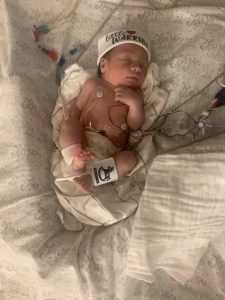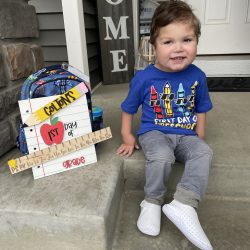Key point
- The Mayo Clinic & Children’s Minnesota Cardiovascular Collaborative enables both health systems to share expertise and knowledge to improve the outcomes for children with serious or complex heart conditions. Sharing expertise and resources allows for the highest quality care and services to patients with complex conditions, including cardiovascular and cardiac surgery, fetal diagnosis and intervention, labor and delivery and neonatology.
Hypoplastic left heart syndrome (HLHS) is a rare and complex congenital heart disease (CHD). In babies with HLHS, the right side of the heart must take on double the work and pump to both the lungs and the rest of the body since the left side of the heart is small and underdeveloped.
Collaborating for Colton
Morgan and Clint never expected their journey to parenthood would include their unborn baby being diagnosed with HLHS at 18 weeks gestation. Patrick O’Leary, MD, pediatric cardiologist at Mayo Clinic, confirmed the diagnosis and Dr. Elizabeth Stephens, a congenital cardiovascular surgeon at Mayo Clinic met with them and discussed the planned series of surgical interventions for children with HLHS. She explained how Mayo Clinic Children’s Center and Children’s Minnesota collaborate to provide a team approach to caring for children with CHD. The Mayo Clinic & Children’s Minnesota Cardiovascular Collaborative enables both health systems to share expertise and knowledge to improve the outcomes for children with serious or complex heart conditions, like Colton.

Morgan’s OB-GYN, Mary Anne Jacob, MD, at Diamond Women’s Center in Edina, referred the family to Midwest Fetal Care Center (MWFCC) in Minneapolis, a collaboration between Allina Health and Children’s Minnesota. MWFCC is a national referral center and regional leader in fetal diagnosis, fetal intervention and comprehensive fetal care for unborn babies with complex conditions.
At MWFCC, the family met with Lisa Howley, MD, medical director of fetal cardiology at Children’s Minnesota. Dr. Howley talked with the family about what to expect for the remainder of the pregnancy, the delivery plan and the postnatal cardiac care Colton would receive as part of the collaboration between Mayo Clinic Children’s Center and Children’s Minnesota.
Delivery and first surgery
Morgan gave birth to Colton via Cesarean section on July 31, 2020, at The Mother Baby Center in Minneapolis. The Mother Baby Center partnership between Allina Health and Children’s Minnesota allowed Colton to receive the care he needed in the Cardiovascular Care Center (CVCC) at Children’s Minnesota immediately after he was born. Soon after, the family met with Colton’s cardiologist, Ian Thomas, MD.
For babies born with HLHS, there are two treatment options: a heart transplant, or far more commonly, a series of surgeries to reconstruct the heart to compensate for the defects. The surgeries, which Children’s Minnesota helped pioneer in 1985, include:

- A Norwood operation: Performed within two weeks of birth, this surgery reconstructs the outflow of the heart using the aorta and pulmonary artery and uses a shunt (small tube graft) to provide the lungs with blood flow.
- A bi-directional Glenn or hemi-Fontan: Performed between four to six months of age, this surgery connects the blood from the head and arms directly to the lungs, providing a stable source of oxygenated blood.
- The Fontan procedure: Performed generally between 3 and 4 years of age, this connects the blood from the lower body directly to the lungs.
The surgery series was the plan for Colton. David Overman, MD, chief of cardiovascular surgery at Children’s Minnesota, and Elizabeth Stephens, MD, congenital cardiovascular surgeon at Mayo Clinic, performed Colton’s Norwood together when he was 6 days old.
Colton spent 103 days in the hospital before he was healthy enough to go home for the first time on Nov. 10, 2020.
Glenn procedure
Two months later, January 2021, Colton returned to Children’s Minnesota for the Glenn procedure which was also jointly performed by Dr. Overman and Dr. Stephens. The surgery went well with no serious issues and Colton was able to return home in 10 days.
Colton’s HLHS isn’t the only issue adding complexity to his care. During his initial hospital admission in 2020, he developed an infection that damaged most of his small intestine and 33% of his large intestine. The damaged portions had to be surgically removed and led to Colton being diagnosed with short bowel syndrome. With that much of his bowel missing, he needed to get nutrition through an IV. In mid-2022, the family traveled to the University of Nebraska Medical Center in Omaha where a surgeon was able to reconnect what remained of Colton’s intestines, improving his quality of life, though he still needs to get some nutrition through an IV.
Colton has also been readmitted to Children’s Minnesota for various medical issues since the Glenn procedure, including a serious blood clot, infections and repairs to the central line.
Fontan procedure
Today, Colton is doing well. He’s not yet a candidate for the third surgery in the HLHS series, the Fontan. If his short bowel syndrome continues to improve, though, his care team is hopeful surgery discussions can begin sometime this year.
Learn more about the Mayo Clinic – Children’s Minnesota Cardiovascular Collaborative or make a referral here.
